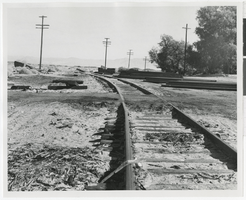Search the Special Collections and Archives Portal
Search Results
Sarann Knight Preddy, Elizabeth Warren, and Woodrow Wilson oral history interview
Identifier
Abstract
Oral history interview with Sarann Knight Preddy, Elizabeth Warren, and Woodrow Wilson conducted by Porter Troutman on July 19, 1977 for the Ralph Roske Oral History Project on Early Las Vegas. In this forum, Knight, Warren, and Wilson discuss the history of West Las Vegas, Nevada. Knight recalls arriving to Las Vegas in 1942 and describes the African American experience at that time. She talks about being the first woman of color to receive a gaming license, dealing cards, and the city ordinance which banned African American dealers. Wilson remembers the living conditions before federal housing and race restrictive covenants in housing. Then, Warren talks about the city's early years, the history of discrimination against African Americans in the city, and the significance of the railroad in Las Vegas. The group answers questions asked by audience members throughout the duration of the forum.
Archival Collection
Wilma Noyes oral history interview
Identifier
Abstract
Oral history interview with Wilma Noyes conducted by Claytee D. White on April 11, 2007 for the Boyer Early Las Vegas Oral History Project. In this interview, Noyes discusses her personal history and life in Las Vegas, Nevada from the 1920s onward. She describes moving to Las Vegas with her family in 1921 after her father got a job working for Union Pacific Railroad Company. Noyes explains how the railroad provided housing to its workers and what life was like in that housing. Noyes discusses attending the first schools in Las Vegas, one of them having had Maude Frazier as its principal. Noyes then describes what young people did for entertainment in Las Vegas, including dancing and going to movie theaters. Lastly, she discusses the history of the casinos and how the city has changed.
Archival Collection

Letter from Roy A. Wehe (San Francisco) to Edward C. Renwick (Los Angeles), November 23, 1951
Date
Archival Collection
Description
If the Union Pacific should divest itself of water production to the Las Vegas Land and Water Company, Wehe describes what the operation of the company should look like. Letter has several date stamps, including one from E. E. Bennett and one from the Union Pacific Railroad Law Department.
Text
J. Ross Clark Photograph Collection
Identifier
Abstract
The J. Ross Clark Photograph Collection (approximately 1900-1920) consists of black-and-white photographic prints and some corresponding negatives. Images depict J. Ross Clark, his wife Miriam Evans Clark, their grandson James Ross Clark II, and several unidentified individuals.
Archival Collection

Photograph of an Amtrak train, Las Vegas, 1979
Date
Archival Collection
Description
Image

Photograph of the new freeway, North Las Vegas, circa early 1970s
Date
Archival Collection
Description
Image

Photograph of railroad reproduction, Las Vegas, 1980
Date
Archival Collection
Description
Image

Photograph of box car, Ralston (Nev.), 1906-1928
Date
Archival Collection
Description
Image

Photograph of interchange railroad track, (Nev.), 1900-1920
Date
Archival Collection
Description
Image

Photograph of a train, (Nev.), circa 1899
Date
Archival Collection
Description
Image
